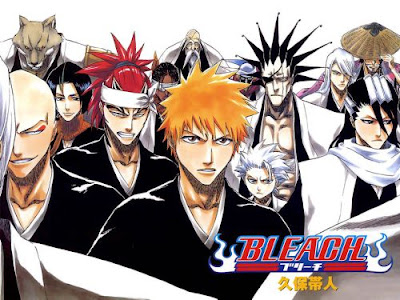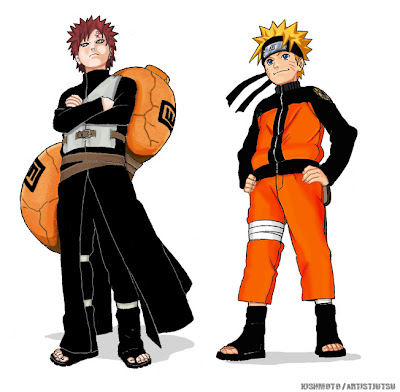
While genin are normally assigned D-Rank missions, Naruto insists on doing something more exciting and the Third Hokage agrees to send them on a C-Rank mission to escort Tazuna, a master bridge builder. During their mission, the team is attacked by two enemy Chunin, something that is not supposed to happen on C-Rank missions, and Naruto panics and freezes. Sasuke, however, deals with the attackers quite efficiently and rubs in his one-upping Naruto by calling him a "scaredy-cat." This name-calling, which Naruto would imitate many times later in the series, is a defining moment in the Naruto-Sasuke rivalry. After the attack, Naruto bleeds out the poison he received by stabbing his wound with a kunai and swears upon his pain to never freeze up and leave his friends to fend for themselves again. Kakashi then tells Naruto that if he looses any more blood, he'll die. Naruto starts panicking, but Kakashi tells Naruto to let him take a look at it. Kakashi is about to treat the wound when he sees that it's already healing. Kakashi then theorizes that this could be a power given to Naruto because of the Nine Tailed Fox.
Tazuna then explains the real mission: the Land of Waves has been taken over by a shipping magnate called Gato, and the only way to revitalize the economy is by building a bridge to the mainland that can bypass Gato's shipping monopoly. However, Gato does not want that to happen, and uses shinobi gangs to get what he wants. Thus Team 7's mission is to support and protect the bridge-building efforts that have been thwarted thus far.
Next, the team is challenged by Zabuza Momochi, who is one of the 7 Swordsmen of the Mist. Early in the battle, Kakashi is trapped in Zabuza's Water Prison Technique and unable to continue fighting. Left to fend for himself, Naruto attempts to run, but feels the pain in his left hand and remembers his earlier vow. In another defining point in Naruto and Team 7's development, Naruto conceives a plan to release Kakashi and Sasuke, with little apparent communication between the two, executes it perfectly. Kakashi, free again, demonstrates the abilities of the Sharingan, defeating Zabuza with both physical and psychological attacks. Though Zabuza should have met his end, he was saved by Haku, who was so skilled with needles that he made it seem as though Zabuza had died, and pretended to be a tracker ninja trying to kill Zabuza.
Team 7 undergoes chakra training, and this becomes another point of rivalry between Naruto and Sasuke, as they constantly challenge themselves to try to outdo each other, but instead end up helping and motivating each other to succeed. They also meet Inari, Tazuna's grandson, who is still brooding over the loss of Kaiza, whom he respected as his father and a local hero, but was killed by Gato.
Eventually, Zabuza and Haku return to make a do or die battle, with some experience as to how they should handle the Konoha ninjas. Haku reveals his Demonic Ice Mirrors jutsu, and completely overpowers Sasuke. Naruto joins the fight and through his own ignorance and impulsiveness gets himself trapped in Haku's jutsu, and is immediateley placed at Haku's mercy. During the course of the fight Sasuke awakens his Sharingan and saves Naruto by sacrificing himself. Naruto asks him why he did that and Sasuke just replied 'How should I know, my body just moved by itself' and then appears to die with 3 needles in his neck. Meanwhile, Zabuza is focused on finding a way to weaken Kakashi's Sharingan.
Naruto's "hidden power" is revealed after he believed Haku killed Sasuke. Naruto loses control and is consumed by the demon fox's chakra. Its power is so immense that the chakra is visible. All of Naruto's wounds heal near-instantaneously, and Naruto's appearance changes; his eyes become red and slitted like a cat, his "whiskers" deepen, his fingernails grow long like claws and his canine teeth become sharper. He completely overwhelms his enemy with this power and speed.





















